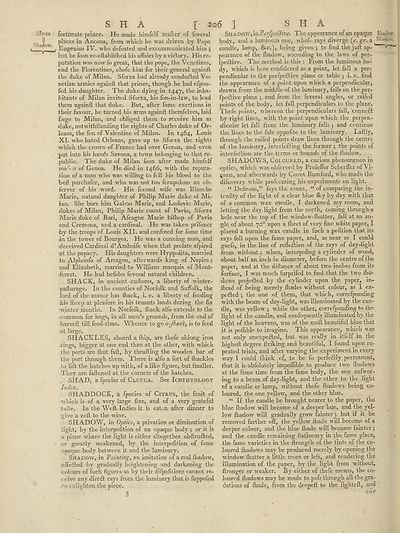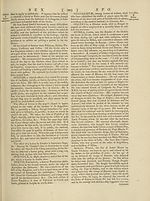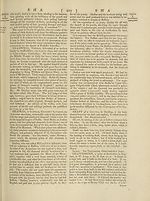Encyclopaedia Britannica, or, a Dictionary of arts, sciences, and miscellaneous literature : enlarged and improved. Illustrated with nearly six hundred engravings > Volume 19, Scripture-SUG
(216) Page 206
Download files
Complete book:
Individual page:
Thumbnail gallery: Grid view | List view

S H A r 2o6 ] s H A
bfor^a fortunate prince. He made himfelf mailer of feveral
, , places In Ancona, from which he was driven by Pope
“ Eugenius IV. who defeated and excommunicated him j
but he foon re-eftabli(hed his affairs by a vidtory. His re¬
putation was now fo great, that the pope, the Venetians,
and the Florentines, chofe him for their general againft
the duke of Milan. Sforza had already conduced Ve¬
netian armies againft that prince, though he had efpou-
fed his daughter. The duke dying in 1447, the inha¬
bitants of Milan invited Sforza, his fon-in-law, to lead
them againft that duke. But, after fome exertions in
their favour, he turned his arms againft themfelves, laid
fxege to Milan, and obliged them to receive him as
duke, notwithftanding the rights of Charles duke of Or¬
leans, the fon of Valentine of Milan. In 1464, Louis
XI. who hated Orleans, gave up to Sforza the rights
which the crown of France had over Genoa, and even
.put into his hands Savona, a town belonging to that re¬
public. The duke of Milan foon after made himfelf
ma'or of Genoa. He died in 1466, with the reputa¬
tion of a man who was willing to fell his blood to the
belt purchafer, and who was not too fcrupulous an ob-
ferver of his word. His fecond wife was Blanche
Marie, natural daughter of Philip Marie duke of Mi¬
lan. She bore him Galeas Marie, and Ludovic Marie,
dukes of Milan, Philip Marie count of Pavia, Sforza
Marie duke of Bari, Afcagne Marie bifhop of Pavia
and Cremona, and a cardinal. He was taken prifoner
by the troops of Louis XII. and confined for fome time
in the tower of Bourges. He wras a cunning man, and
deceived Cardinal d’Amboife ■when that prelate afpired
ut the papacy. His daughters were Hyppolita, married
to Alphonfo of Arragon, afterwards king of Naples 4
and Elizabeth, married to William marquis of Mont-
ferrat. He had befides feveral natural children.
SHACK, in ancient cuftoms, a liberty of winter-
-pafturage. In the counties of Norfolk and Suffolk, the
lord of the manor has {hack, i. e. a liberty of feeding
his {beep at pleafure in his tenants lands during the fix
w.inter months. In Norfolk, ftiack alfo extends to the
common for hogs, in all men’s grounds, from the end of
•harveft till feed-time. Whence to go a-Jhack, is to feed
at large.
SHACKLES, aboard a fhip, are thofe oblong iron
rings, bigger at one end than at the other, with which
the ports are ftmt fall, by thrufting the wooden bar of
the port through them. There is alfo a fort of {hackles
to lift the hatches up with, of a like figure, but fmaller.
They are faftened at the corners of the hatches.
SHAD, a fpecies of Clupea. See Ichthyology
Index.
SHADDOCK, a fpecies of Citrus, the fruit of
which is of a very large fize, and of a very grateful
tafte. In the Weft Indies it is eaten after dinner to
give a zeft to the wine.
SHADOW, in Optics, a privation or diminution of
light, by the interpofition of an opaque body •, or it is
a plane where the light is either altogether obftrudted,
or greatly weakened, by the interpofition of fome
opaque body between it and the luminary-.
Shadow, in Tainting, an imitation of a real Ihadow,
effedted by gradually heightening and darkening the
colours of fuch figures as by their difpofitions cannot re¬
ceive any diredl rays from the luminary that is fuppofed
to enlighten the piece.
3
Shadow7, in PcrfpecHve. The appearance of an opaque Shadow,
body, and a luminous one, whofc rays diverge {e. gr. a i Shadows,
candle, lamp, &c.), being given j to find the juft ap-
pearance of the ftiadow, according to the laws of per-
fpeftive. The method is this : From the luminous bo¬
dy, which is here confidered as a point, let fall a per¬
pendicular to the perfpedlive plane or table j i. e. find
the appearance of a point upon which a perpendicular,
drawn from the middle of the luminary, falls on the per-
fpeftive plane ; and from the feveral angles, or raifed
points of the body, let fall perpendiculars to the plane.
Thefe points, whereon the perpendiculars fall, conneft
by right lines, with the point upon which the perpen¬
dicular let fall from the luminary falls j and continue
the lines to the fide oppofite to the luminary. Laftly,
through the raifed points draw lines through the centre
of the luminary, interfering the former 5 the points of
interfetlion are the terms or bounds of the fliadow.
SHADOWS, Coloured, a curious phenomenon in
optics, which was obferved by Profeffor Scherffer of Vi¬
enna, and afterwards by Count Rumford, who made the
difeovery while profecuting his experiments on light.
“ Defirous,” fays the count, “ of comparing the in-
tenfity of the light of a clear blue Iky by day with that
of a common wax candle, I darkened my room, and
letting the day-light from the north, coming through a
hole near the top of the window-fhutter, fall at an an¬
gle of about 70° upon a fheet of very fine white paper, I
placed a burning wax candle in fuch a pofition that its
rays fell upon the fame paper, and, as near as I could
guefs, in the line of refledion of the rays of day-light
from without 4 when, interpofing a cylinder of wood,
about half an inch in diameter, before the centre of the
paper, and at the diftance of about twm inches from its
furface, I was much furprifed to find that the two Iha-
dows projefted by the cylinder upon the paper, in-
ftead of being merely {hades without colour, as I ex*-
petted 5 the one of them, that which, correfponding
with the beam of day-light, was illuminated by the can¬
dle, was yellow ,5 rvhile the other, correfponding to the
light of the candle, and confequently illuminated by the
light of the heavens, wras of the moft beautiful blue that
it is poflible to imagine. This appearance, which was
not only unexpetted, but was really in itfelf in the
higheft degree ftriking and beautiful, I found upon re¬
peated trials, and after varying the experiment in every
wTay I could think of, to be fo perfettly permanent,
that it is abfolutely impofilble to produce two ftiadorvs
at the fame time from the fame body, the one anfwer-
ing to a beam of day-light, and the other to the light
of a candle or lamp, without thofe fhadows being co¬
loured, the one yellow, and the other blue.
“ If the candle be brought nearer to the paper, the
blue fhadow will become of a deeper hue, and the yel¬
low {hadow will gradually grow fainter $ but if it be
removed farther off, the yellow {hade w ill become of a
deeper colour, and the blue {hade will become fainter 5
and the candle remaining ftationary in the fame place,
the fame varieties in the ftrength of the tints of the co¬
loured Ihadows may be produced merely by opening the
window-(hutter a little more or lefs, and rendering the
illumination of the paper, by the light from without,
ftronger or w’eaker. By either of thefe means, the co¬
loured fihadows may be made to pafs through all the gra¬
dations of ftiade, from the deepeft to the lighteft, and
vice
bfor^a fortunate prince. He made himfelf mailer of feveral
, , places In Ancona, from which he was driven by Pope
“ Eugenius IV. who defeated and excommunicated him j
but he foon re-eftabli(hed his affairs by a vidtory. His re¬
putation was now fo great, that the pope, the Venetians,
and the Florentines, chofe him for their general againft
the duke of Milan. Sforza had already conduced Ve¬
netian armies againft that prince, though he had efpou-
fed his daughter. The duke dying in 1447, the inha¬
bitants of Milan invited Sforza, his fon-in-law, to lead
them againft that duke. But, after fome exertions in
their favour, he turned his arms againft themfelves, laid
fxege to Milan, and obliged them to receive him as
duke, notwithftanding the rights of Charles duke of Or¬
leans, the fon of Valentine of Milan. In 1464, Louis
XI. who hated Orleans, gave up to Sforza the rights
which the crown of France had over Genoa, and even
.put into his hands Savona, a town belonging to that re¬
public. The duke of Milan foon after made himfelf
ma'or of Genoa. He died in 1466, with the reputa¬
tion of a man who was willing to fell his blood to the
belt purchafer, and who was not too fcrupulous an ob-
ferver of his word. His fecond wife was Blanche
Marie, natural daughter of Philip Marie duke of Mi¬
lan. She bore him Galeas Marie, and Ludovic Marie,
dukes of Milan, Philip Marie count of Pavia, Sforza
Marie duke of Bari, Afcagne Marie bifhop of Pavia
and Cremona, and a cardinal. He was taken prifoner
by the troops of Louis XII. and confined for fome time
in the tower of Bourges. He wras a cunning man, and
deceived Cardinal d’Amboife ■when that prelate afpired
ut the papacy. His daughters were Hyppolita, married
to Alphonfo of Arragon, afterwards king of Naples 4
and Elizabeth, married to William marquis of Mont-
ferrat. He had befides feveral natural children.
SHACK, in ancient cuftoms, a liberty of winter-
-pafturage. In the counties of Norfolk and Suffolk, the
lord of the manor has {hack, i. e. a liberty of feeding
his {beep at pleafure in his tenants lands during the fix
w.inter months. In Norfolk, ftiack alfo extends to the
common for hogs, in all men’s grounds, from the end of
•harveft till feed-time. Whence to go a-Jhack, is to feed
at large.
SHACKLES, aboard a fhip, are thofe oblong iron
rings, bigger at one end than at the other, with which
the ports are ftmt fall, by thrufting the wooden bar of
the port through them. There is alfo a fort of {hackles
to lift the hatches up with, of a like figure, but fmaller.
They are faftened at the corners of the hatches.
SHAD, a fpecies of Clupea. See Ichthyology
Index.
SHADDOCK, a fpecies of Citrus, the fruit of
which is of a very large fize, and of a very grateful
tafte. In the Weft Indies it is eaten after dinner to
give a zeft to the wine.
SHADOW, in Optics, a privation or diminution of
light, by the interpofition of an opaque body •, or it is
a plane where the light is either altogether obftrudted,
or greatly weakened, by the interpofition of fome
opaque body between it and the luminary-.
Shadow, in Tainting, an imitation of a real Ihadow,
effedted by gradually heightening and darkening the
colours of fuch figures as by their difpofitions cannot re¬
ceive any diredl rays from the luminary that is fuppofed
to enlighten the piece.
3
Shadow7, in PcrfpecHve. The appearance of an opaque Shadow,
body, and a luminous one, whofc rays diverge {e. gr. a i Shadows,
candle, lamp, &c.), being given j to find the juft ap-
pearance of the ftiadow, according to the laws of per-
fpeftive. The method is this : From the luminous bo¬
dy, which is here confidered as a point, let fall a per¬
pendicular to the perfpedlive plane or table j i. e. find
the appearance of a point upon which a perpendicular,
drawn from the middle of the luminary, falls on the per-
fpeftive plane ; and from the feveral angles, or raifed
points of the body, let fall perpendiculars to the plane.
Thefe points, whereon the perpendiculars fall, conneft
by right lines, with the point upon which the perpen¬
dicular let fall from the luminary falls j and continue
the lines to the fide oppofite to the luminary. Laftly,
through the raifed points draw lines through the centre
of the luminary, interfering the former 5 the points of
interfetlion are the terms or bounds of the fliadow.
SHADOWS, Coloured, a curious phenomenon in
optics, which was obferved by Profeffor Scherffer of Vi¬
enna, and afterwards by Count Rumford, who made the
difeovery while profecuting his experiments on light.
“ Defirous,” fays the count, “ of comparing the in-
tenfity of the light of a clear blue Iky by day with that
of a common wax candle, I darkened my room, and
letting the day-light from the north, coming through a
hole near the top of the window-fhutter, fall at an an¬
gle of about 70° upon a fheet of very fine white paper, I
placed a burning wax candle in fuch a pofition that its
rays fell upon the fame paper, and, as near as I could
guefs, in the line of refledion of the rays of day-light
from without 4 when, interpofing a cylinder of wood,
about half an inch in diameter, before the centre of the
paper, and at the diftance of about twm inches from its
furface, I was much furprifed to find that the two Iha-
dows projefted by the cylinder upon the paper, in-
ftead of being merely {hades without colour, as I ex*-
petted 5 the one of them, that which, correfponding
with the beam of day-light, was illuminated by the can¬
dle, was yellow ,5 rvhile the other, correfponding to the
light of the candle, and confequently illuminated by the
light of the heavens, wras of the moft beautiful blue that
it is poflible to imagine. This appearance, which was
not only unexpetted, but was really in itfelf in the
higheft degree ftriking and beautiful, I found upon re¬
peated trials, and after varying the experiment in every
wTay I could think of, to be fo perfettly permanent,
that it is abfolutely impofilble to produce two ftiadorvs
at the fame time from the fame body, the one anfwer-
ing to a beam of day-light, and the other to the light
of a candle or lamp, without thofe fhadows being co¬
loured, the one yellow, and the other blue.
“ If the candle be brought nearer to the paper, the
blue fhadow will become of a deeper hue, and the yel¬
low {hadow will gradually grow fainter $ but if it be
removed farther off, the yellow {hade w ill become of a
deeper colour, and the blue {hade will become fainter 5
and the candle remaining ftationary in the fame place,
the fame varieties in the ftrength of the tints of the co¬
loured Ihadows may be produced merely by opening the
window-(hutter a little more or lefs, and rendering the
illumination of the paper, by the light from without,
ftronger or w’eaker. By either of thefe means, the co¬
loured fihadows may be made to pafs through all the gra¬
dations of ftiade, from the deepeft to the lighteft, and
vice
Set display mode to:
![]() Universal Viewer |
Universal Viewer | ![]() Mirador |
Large image | Transcription
Mirador |
Large image | Transcription
Images and transcriptions on this page, including medium image downloads, may be used under the Creative Commons Attribution 4.0 International Licence unless otherwise stated. ![]()
| Permanent URL | https://digital.nls.uk/192698090 |
|---|
| Attribution and copyright: |
|
|---|
| Description | Ten editions of 'Encyclopaedia Britannica', issued from 1768-1903, in 231 volumes. Originally issued in 100 weekly parts (3 volumes) between 1768 and 1771 by publishers: Colin Macfarquhar and Andrew Bell (Edinburgh); editor: William Smellie: engraver: Andrew Bell. Expanded editions in the 19th century featured more volumes and contributions from leading experts in their fields. Managed and published in Edinburgh up to the 9th edition (25 volumes, from 1875-1889); the 10th edition (1902-1903) re-issued the 9th edition, with 11 supplementary volumes. |
|---|---|
| Additional NLS resources: |
|

